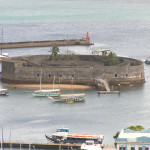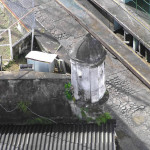Written by Marco Ramerini. English text revision by Dietrich Köster.
Right from the founding of the city the Portuguese started with the construction of a defensive system against foreign invasions, which occurred until the 18th century.
The main works of fortification were executed after the Dutch conquest of the town (1624-1625) and the successive reconquest by the Portuguese. Fearing another Dutch invasion, which materialized in 1638 and 1647, they started with the building of several forts to defend Salvador, the capital of the Brazilian colony.
FORTE DE SANTO ANTÔNIO DA BARRA
The first fortification on this place was built between 1583 and 1587 during the government of D. Manuel Telles Barreto: a poligonal tower of “taipa”.

A better fortification was built during the government of D. Francisco de Souza (1591-1602). This time it was a fort with an octagonal shape and was artilled with 4 cannons. In 1624 the fortification did not resist the Dutch landing in the port.
During the govern of D. João de Lencastre, between 1696 and 1702, the fort got its current shape due to the project of the engineer João Coutinho. Its design, as in other fortifications, is in the Italian style. The access is by a ramp tunnel, ending in a stairway.
[divider]
[divider]

FORTE DE SANTA MARIA
This fort was built, “de pedra e cal” during the government of D. Diogo Luís de Oliveira (1627-1635). Itis certain, that during the second Dutch invasion in 1638 the fort was part of the city defences. In 1671 it had 1 bronze cannon and 2 iron cannons, but according to the “Relatório, 1671” it needed three more cannons. It has an Italian-style design and was built in stonemasonry.
[divider]
[divider]

FORTE DE SÃO DIEGO
This fort was built, “de pedra e cal” during the government of D. Diogo Luís de Oliveira (1627-1635). With the forts of Santa Maria and Santo Antônio da Barra it is a part of the defense system of Porto da Barra. It has an irregular shape and it is built at the foot of the hill, where the original Vila Velha de Pereira Coutinho was situated.
[divider]

FORTE DE NOSSA SENHORA DO PÓPULO E SÃO MARCELO (FORTE DO MAR)
This is a circular fort. Its construction during the government of Francisco Barreto (1657-1663), far from the shore is due to the fear of a new invasion. Its objective was to avoid any invasion of the port. In the 1670s it had 9 cannons. Its slightly circular project is formed by a central turret, surrounded by a ring of equal height, constituting the perimeter and the quarters. It was built in sandstone up to the waterline and the remaining in stonemasonry.
[divider]
[divider]

FORTE DE NOSSA SENHORA DE MONTSERRAT
Montserrat Fort is located in the western part of the Itapagipana Peninsula. Probably it was built in 1586 during the government of D. Manuel Telles Barreto (1583-1587). Its construction was continued during the government of D. Francisco de Souza (1591-1602), when it was known as Castelo de São Felipe. Perhaps it was designed by Baccio da Filicaia 1565 Firenze – 1628 Salvador/Bahia), who worked under this governor.
Its design is inspired by the Italian fortification style and it is one of the best examples of early military architecture in Brazil. Its shape is an irregular polygon with circular turrets. It had 3 cannons and from the fort, the entire Port of Salvador could be protected. In 1616 its garrison was composed by 16 men: a captain, a head, a gunner, a tamburine and 12 musketeers. On 9 May 1624 this fort, which had 4 cannons, was attacked by the Dutch army. After a furious resistence the garrison was forced to surrender.
During the Dutch occupation the Portugueses built in the vicinities of the fort a trench, where they placed 2 bronze cannons. Captain Manuel Gonçalves succeeded during one of the numerous attacks the Portuguese directed towards the garrison of the fort in capturing the commander of the fort. On 17 July 1624 general Johan Van, the Dutch commander of the troops of the garrison of Salvador was attacked and killed in the locality Água de Meninos, while he was returning with 200 men from an inspection of the Montserrat Fort. In 1625 the Hispano-Portuguese under D. Fradique de Toledo retook the fort and on 1 May 1625 the entire Dutch garrison of Salvador capitulated.
In 1638 a Dutch army under Johann Moritz von Nassau-Siegen put under siege Salvador and on 21 April 1638 a platoon under Major van den Brand attacked the fort of Montserrat, which soon capitulated, the captain of the fort at that time being Pedro Aires de Aguirre. This time the Dutch were forced to abandon the siege of the city after a month (16 April 1638-26 May 1638).
In October 1655 the Conde de Ataugia ordered to rebuild the fortress and later in 1693 D. João de Lencastre ordered the same. During these reconstruction works the fort reached the actual hexagonal shape with a tower at each angle. In 1717 it had 12 cannons.
[divider]
[divider]

FORTE DE SÃO PEDRO
The first fortification in the area dates from 1624 and construction work started by the Dutch during their brief occupation of Salvador (1624-1625). In 1648 the old trench was replaced by a fort. Located on a strategic place, Fort São Pedro, along with Fort São Paulo da Gamboa, played a main role in the defense of the south portion of the city. In 1671 it had only 2 cannons. During the government of Roque da Costa Barreto (1678-1682) the fort was repaired. During the 1710s the fort was improved and the works were terminatad on 12 August 1723. In 1759 it had 5 bronze “colubrinas”, 1 bronze “morteiro” and 37 iron cannons. It is a stonemasonry construction. The fort has a quadrangular polygonal shape, possessing bastions on each side with turret-shaped watch posts.
[divider]
[divider]
[divider]
BIBLIOGRAPHY:











